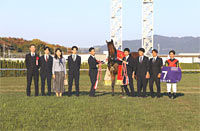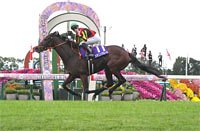Queen Elizabeth II Cup (G1) - Data Analysis
Strong fillies and mares battle for the title of queen
The Queen Elizabeth II Cup, which determines the autumn queen, has historically unfolded as a clash between three-year-olds that have primarily competed against same-generation runners, on the one hand, and older horses with a proven track record, on the other. In recent years, the race has been won by well-known fillies and mares with strong records that transcend same-gender races. Examples include Lys Gracieux (who went on to secure three consecutive wins in domestic/international G1 races in the following year), as well as Osaka Hai winner Lucky Lilac and Takarazuka Kinen winner Marialite. Let’s now look for some strategies to determine runners that may claim the title of queen based on results over the last 10 years, including the races held at Hanshin Racecourse from 2020 to 2022.
Look out for dark horses
Although the races held at Hanshin Racecourse have produced notable upsets, as evidenced by the Trifecta payout of 3,000,000 yen in 2021, 20 of the 30 Top 3 finishers over the last 10 years were backed as 5th favorite or higher. In the 2023 race, held at Kyoto Racecourse after a three-year hiatus, race favorite Brede Weg secured the victory, resulting in a Trifecta payout of 9,780 yen. However, highly favored runners have not always dominated the races at Kyoto Racecourse. From 2014 to 2019, dark horses backed by favoritism of 6th or lower consistently finished in the Top 3. In other words, while our focus should remain on highly favored runners, it may be a good idea to slightly broaden our selection scope when it comes to favoritism. [Table 1]
[Table 1] Performance by favoritism (last 10 years)
| Favoritism |
Performance
[1st-2nd-3rd-4th or lower] |
Win ratio |
Top 2 ratio |
Top 3 ratio |
| 1st favorite |
2-2-2-4 |
20.0% |
40.0% |
60.0% |
| 2nd favorite |
0-0-1-9 |
0% |
0% |
10.0% |
| 3rd favorite |
4-0-3-3 |
40.0% |
40.0% |
70.0% |
| 4th favorite |
1-0-1-8 |
10.0% |
10.0% |
20.0% |
| 5th favorite |
1-3-0-6 |
10.0% |
40.0% |
40.0% |
| 6th-9th favorite |
1-4-2-33 |
2.5% |
12.5% |
17.5% |
| 10th favorite or lower |
1-2-0-79 |
1.2% |
3.7% |
3.7% |
Note: Two runners tied for 2nd in 2022.
Focus on runners coming from G2 races
Looking at performances over the last 10 years in terms of the previous race, we find that 20 of the 30 Top 3 finishers had come from a G2 race, 12 of which had previously contested the Fuchu Himba Stakes. Runners that had won the Fuchu Himba Stakes delivered performance of [1-2-1-4], with half finishing in the Top 3. In addition, 2016 runner-up Sing with Joy (backed as 12th favorite) and 2021 winner Akai Ito (backed as 10th favorite) had both previously finished 7th in the Fuchu Himba Stakes. While runners that have finished 10th or lower in their previous race are likely to struggle, we should keep an eye on runners with a 1st-9th finish in the Fuchu Himba Stakes, regardless of their favoritism. [Table 2]
[Table 2] Performance by previous race (last 10 years)
| Previous race |
Performance
[1st-2nd-3rd-4th or lower] |
Win ratio |
Top 2 ratio |
Top 3 ratio |
| Shuka Sho |
1-3-2-21 |
3.7% |
14.8% |
22.2% |
| Other JRA G1 race |
0-0-3-3 |
0% |
0% |
50.0% |
| Fuchu Himba Stakes |
4-6-2-38 |
8.0% |
20.0% |
24.0% |
| All Comers |
3-1-0-13 |
17.6% |
23.5% |
23.5% |
| Sapporo Kinen |
1-1-1-1 |
25.0% |
50.0% |
75.0% |
Kansai Telecasting Corp. Sho
Rose Stakes (Shuka Sho Trial) |
1-0-0-0 |
100% |
100% |
100% |
| Other race |
0-0-1-66 |
0% |
0% |
1.5% |
Note: Two runners tied for 2nd in 2022.
Runners that had previously contested the Shuka Sho were the second largest in number, behind those coming from the Fuchu Himba Stakes. In this group, runners that had finished in the Top 2 of the Shuka Sho did not fare well, so we should focus our attention on runners that had been beaten to 3rd or lower. For example, 2021 runner-up Stellaria (backed as 7th favorite) had finished 6th in the Shuka Sho, while 2022 runner-up Lilac (backed as 12th favorite) had finished 10th in the same race. We should therefore look out for rebound performances by runners that have suffered major defeats in the Shuka Sho. [Table 3]
[Table 3] Among runners coming from the Shuka Sho, performance by finish in that race (last 10 years)
| Finish in Shuka Sho |
Performance
[1st-2nd-3rd-4th or lower] |
Win ratio |
Top 2 ratio |
Top 3 ratio |
| Top 2 |
0-1-0-9 |
0% |
10.0% |
10.0% |
| 3rd or lower |
1-2-2-12 |
5.9% |
17.6% |
29.4% |
Strong performance by runners with experience of finishing in the Top 2 of a JRA G1 race
Although runners coming from a Top 2 finish in the Shuka Sho have tended to struggle, 17 of the 30 Top 3 finishers over the last 10 years had experience of finishing in the Top 2 of a JRA G1 race. If we limit our analysis to four-year-olds with such experience, we find that runners in this group achieved performance of [4-1-3-7], corresponding to a Top 3 ratio of over 50%. If any of this year’s runners has such a record, we should consider them strong candidates. [Table 4]
[Table 4] Performance by experience of finishing in the Top 2 of a JRA G1 race (last 10 years)
| Experience |
Performance
[1st-2nd-3rd-4th or lower] |
Win ratio |
Top 2 ratio |
Top 3 ratio |
| Yes |
6-5-6-37 |
11.1% |
20.4% |
31.5% |
| No |
4-6-3-105 |
3.4% |
8.5% |
11.0% |
Note: Two runners tied for 2nd in 2022.
Watch runners that enjoyed success in the year-earlier Queen Elizabeth II Cup
Over the last 10 years, seven runners achieved Top 3 finishes in the Queen Elizabeth II Cup in two consecutive years, including Crocosmia, who secured three consecutive second-place finishes from 2017 to 2019. Runners that had finished in the Top 3 of the year-earlier Queen Elizabeth II Cup delivered performance of [2-3-3-9], with nearly half of the runners in this group finishing in the Top 3. If any of last year’s Top 3 finishers enter the race this year, we should keep an eye on them. [Table 5]
[Table 5] Runners that achieved consecutive Top 3 finishes in the Queen Elizabeth II Cup (last 10 years)
| Year |
Finish |
Horse (finish in year-earlier Queen Elizabeth II Cup) |
| 2014 |
1st |
Lachesis (2nd) |
| 2015 |
2nd |
Nuovo Record (2nd) |
| 2017 |
3rd |
Mikki Queen (3rd) |
| 2018 |
2nd |
Crocosmia (2nd) |
| 3rd |
Mozu Katchan (1st) |
| 2019 |
2nd |
Crocosmia (2nd) |
| 2020 |
1st |
Lucky Lilac (1st) |
| 3rd |
Loves Only You(3rd) |
Seek out the winner!
Distinct trend in age of winners
Although five-year old Lucky Lilac secured the victory in 2020, showcasing a grace worthy of her status as the year-earlier champion, younger runners have generally turned in strong performance over the last 10 years, with nine of the 10 recent winners being aged 4 or below. In addition, nine of the 10 winners came from a G2 race, as shown in Table 2. Combining these two factors, we can conclude that runners aged 4 or below coming from a G2 race are the top contenders to win the race. [Table 6]
[Table 6] Winners’ age and previous race (last 10 years)
| Year |
Winner |
Age |
Previous race |
| 2014 |
Lachesis |
4 |
All Comers (G2) |
| 2015 |
Marialite |
4 |
All Comers (G2) |
| 2016 |
Queens Ring |
4 |
Fuchu Himba Stakes (G2) |
| 2017 |
Mozu Katchan |
3 |
Shuka Sho (G1) |
| 2018 |
Lys Gracieux |
4 |
Fuchu Himba Stakes (G2) |
| 2019 |
Lucky Lilac |
4 |
Fuchu Himba Stakes (G2) |
| 2020 |
Lucky Lilac |
5 |
Sapporo Kinen (G2) |
| 2021 |
Akai Ito |
4 |
Fuchu Himba Stakes (G2) |
| 2022 |
Geraldina |
4 |
All Comers (G2) |
| 2023 |
Brede Weg |
3 |
Kansai Telecasting Corp. Sho Rose Stakes (Shuka Sho Trial) (G2) |
(Maya Takanami)
|



















